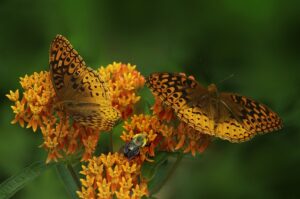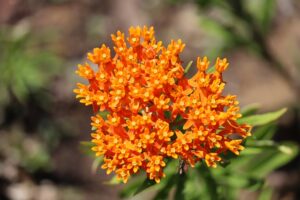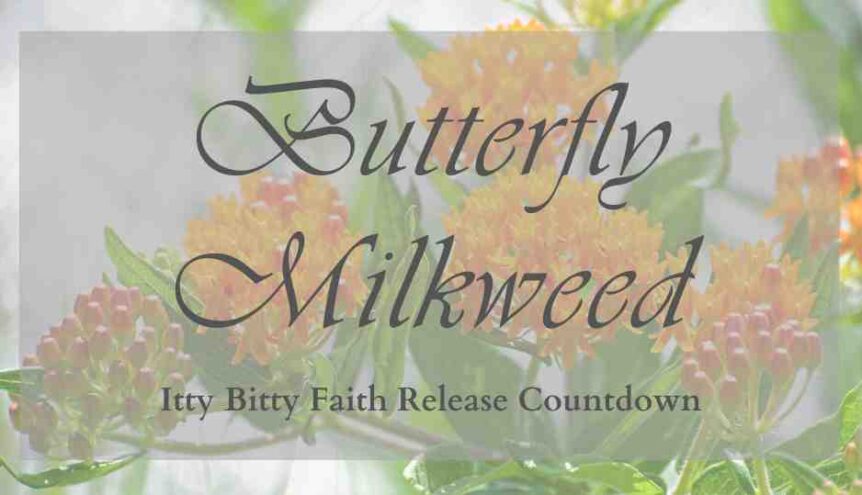 The first I’d ever heard of milkweed as a garden plant was from an elderly woman in our church who is known for her amazing green thumb. You want to know about any flowering plant—ask Carol. Last summer, she gave Chris a milkweed plant as a gift because he had heard the fluff of the spent blooms were a great source for tracking the direction of the wind. In case you’re wondering how this intricate tracking system works, he holds the fluff from the pods up in the air, and whichever way they blow, that’s the direction the wind is going. Whatever happened to licking your finger and holding it up to see which side dries fastest? Isn’t that how Daniel Boone did it?
The first I’d ever heard of milkweed as a garden plant was from an elderly woman in our church who is known for her amazing green thumb. You want to know about any flowering plant—ask Carol. Last summer, she gave Chris a milkweed plant as a gift because he had heard the fluff of the spent blooms were a great source for tracking the direction of the wind. In case you’re wondering how this intricate tracking system works, he holds the fluff from the pods up in the air, and whichever way they blow, that’s the direction the wind is going. Whatever happened to licking your finger and holding it up to see which side dries fastest? Isn’t that how Daniel Boone did it?
But to be honest, I’m not all that interested in assessing wind direction. I’m highlighting this plant for more selfish reasons—the butterfly milkweed (aka butterfly weed) is one of the best plants for a butterfly or pollinator garden. Butterfly milkweed plants are the host plants for the monarch butterfly caterpillars as their narrow leaves are a must-have food source for milkweed butterfly larvae (caterpillars) and their flowers attract a wide variety of butterflies and other pollinators.
The Latin name for butterfly weed plants is Ascelpias tuberoso, in case that’s important to you. They are trouble-free North American natives that produce umbels of bright orange, yellow, or red blooms all summer long. The nectar and pollen rich flowers attract not only hordes of butterflies, but hummingbirds, bees, and other beneficial insects (no, that is not an oxymoron) throughout the summer.
 The butterfly weed is a cousin to the plain old milkweed with tall, clumping perennials that reach from 12-36 inches. The blooms appear on top of fuzzy, green stems, and have attractive, lance-shaped leaves. Butterfly weed grows wild in a variety of environments, including open woods, prairies, dry fields, meadows, and along roadsides. In the garden, butterfly weed looks great in wildflower meadows, borders, rock gardens, or mass plantings. They do best in full sun and well-draining soil. After flowering, large oblong seed pods burst open in the fall and reveal a mass of soft, white, fluffy seeds—which is what my husband uses to track the direction of the wind. This is how the plants spread their seeds.
The butterfly weed is a cousin to the plain old milkweed with tall, clumping perennials that reach from 12-36 inches. The blooms appear on top of fuzzy, green stems, and have attractive, lance-shaped leaves. Butterfly weed grows wild in a variety of environments, including open woods, prairies, dry fields, meadows, and along roadsides. In the garden, butterfly weed looks great in wildflower meadows, borders, rock gardens, or mass plantings. They do best in full sun and well-draining soil. After flowering, large oblong seed pods burst open in the fall and reveal a mass of soft, white, fluffy seeds—which is what my husband uses to track the direction of the wind. This is how the plants spread their seeds.
And here is another plus for these beauties—they’re deer resistant and drought tolerant. Yay.
You may not be able to purchase these beauties on Amazon, but be sure to enter here for a chance to win a $25 Gift Card anyway. Maybe you can use them for gardening tools, or seeds, or a book!







Comments 2
I found that my parsley was a great hit with the black swallowtail butterfly. I have watched at least two caterpillars a year survive to hatch from their chrysalis. This year I had two patches, but the birds got the caterpillars from one of them.
Author
That must be such a joy to see. Isn’t nature just amazing?